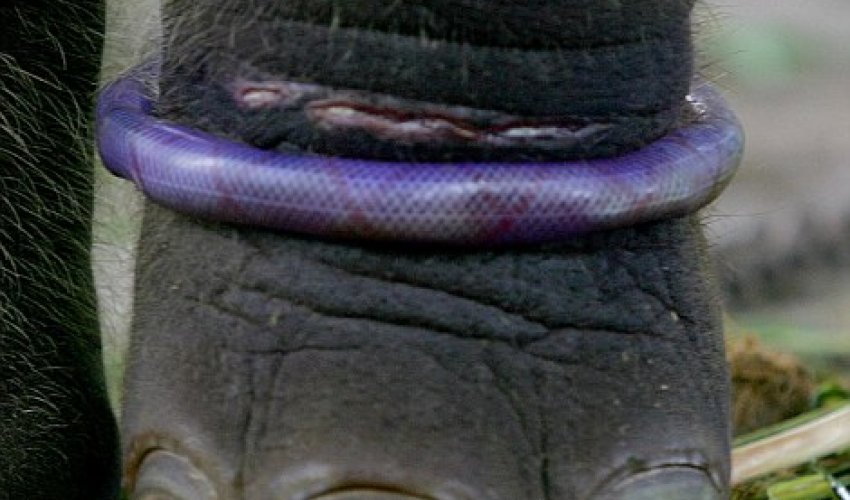World's cruellest zoo - PHOTO

The young elephant has tugged at his shackled hind leg so often that the manacles have cut through the flesh, leaving it raw.Not that freeing himself would help. A chain on his left front leg means he can move neither forwards, backwards nor sideways.The elephant’s owner has tethered the youngster because he prefers to tend to his small shop in the grounds of the Surabaya Zoo in Indonesia.Money comes first. And so, day after day, week after week, the elephant stands there, being released from his chains only at the end of each day.Anyone finding the scene depressing, and who turns away to look for more happy animals in the zoo would eventually leave, as I did, utterly depressed.Surabaya Zoo has been branded the worst in the world and when I walked through this animal torture ground I was left in no doubt its reputation was well earned.I live near Sydney harbour where it is a joy to watch pelicans gliding low across the waters of Blackwattle Bay. But at the Surabaya Zoo I could only shake my head in despair at the sight of more than 150 pelicans jammed into a cage, trying to share a small pool of water, so tightly packed that they could not even spread their wings, let alone fly.‘How many pelicans does this zoo need?’ I asked a keeper. ‘They’re not endangered. There’s no need to keep this many penned in.’ He knew what I said, but I received only shrugs.Each step took me through a macabre animal dungeon. While I saw dishes of chopped vegetables for the primates, the ribs of several large animals could be seen. One camel in particular appeared appallingly thin. A capuchin monkey I came across appeared to almost plead to be released.In another cage, a sad rhinocerous hornbill looks up at the blue sky, trying to take off from its perch, but there is no room to flap its wings.Well over 50 animals have died here in the past three months, says Tony Sumampau, a former member of the zoo’s temporary management team, who had finally left in despair. ‘The keepers have stalls that they run selling food and drinks and it’s more important for them to make money than it is to be taking care of their animals.’The zoo, was opened in 1916 during Dutch colonial rule, and next to nothing has been done to improve it. Instead, more and more animals have been packed in.A report by an independent team set up by Indonesia’s forestry ministry called for the animals be moved to other zoos but nothing has been done. Other zoos refuse to take the animals because of their condition and the fear that many of them carrying diseases.The state of the zoo’s animals came to world-wide attention following the death of a giraffe in 2012 that was found with no less than 20 kilograms of plastic bags in its stomach. They had blown into its enclosure and the keepers had not bothered to pick them up.The giraffe’s death would possibly have faded from the world’s conscience had it not been for the discovery of a dead female orangutan, Nanik, in its enclosure a few weeks ago. Orangutans, an endangered species, live up to the age of 60 in captivity, but Nanik was just 12 years old when she died, a large tumour being found in her intestines.Sitting alone is another orangutan. I cannot believe what I see – she is chewing on the yellow top of a marker pen someone has thrown at her. She pushes it forward between her lips, then sucks it back into her mouth. I fear she will soon swallow it. Beside her, rats scurry in and out of holes in an embankment. I stare at a Sumatran tiger – or rather just its face – as it peers out from behind the bars of its stone living quarters. One of its brothers, I was told, had been seriously ill with its digestive tract rotted away due to the formaldehyde-laced meat it had been fed. An African lion is reported to have died in pain, adding to the zoo’s shameful catelogue of deaths from starvation, mistreatment and other unnatural causes.Agus Supangkat, a spokesman for the zoo, insisted conditions had improved in the past year, but accepted that ‘we also have issues’. The Jakarta Globe has reported that data it had acquired showed that 43 animals had died at the zoo between July 15 and September 17 this year. The zoo, claims however, that the animals on the list died because they were old or had diseases.The 3,000 or so creatures that live in these appalling conditions are destined to die here, naturally or through neglect, but one thing is certain they will not die happily unless something is done urgently. A final glance at the baby elephant with three legs tethered leaves me in no doubt of tha(dailymail.co.uk)ANN.Az
Similar news
Similar news
Latest news 
More news 



































 Photo
Photo 



 Video
Video 

